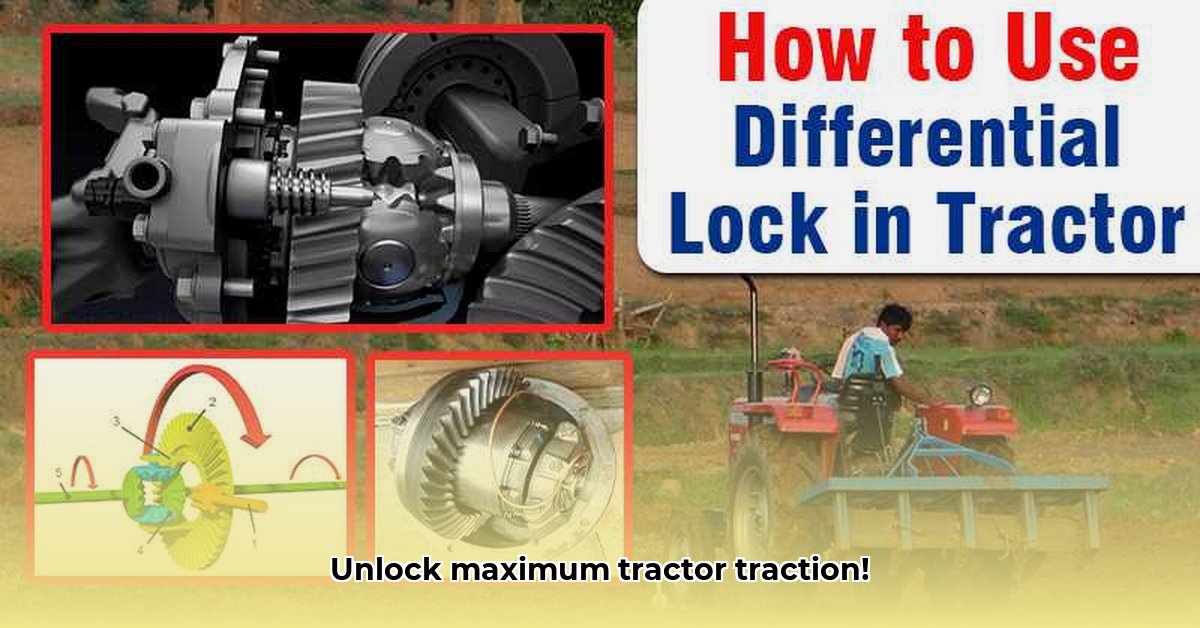
Tractor Differential: Your Ticket to Better Traction
Your tractor's differential is a critical component for smooth operation and efficient work. This unsung hero allows your wheels to rotate at different speeds when turning, preventing wheel slippage and maximizing control. Without it, even simple maneuvers would become significantly more difficult. Think of it as the key to navigating challenging terrains. For more information on tractor attachments, check out this helpful resource.
Understanding How Your Tractor's Differential Works
When turning, the inside wheels travel a shorter distance than the outside wheels. The differential is a gearbox that enables this difference in rotational speed, ensuring smooth turns even when both wheels are powered. This is vital for maneuverability, especially in confined spaces.
Differential Locks: Your Traction Allies
In tough conditions (mud, ice, snow), a standard differential can hinder traction. One wheel might spin while the other remains stuck. A differential lock is the solution, acting like a four-wheel-drive system for the rear axle. It locks the rear axles together, forcing both wheels to rotate at the same speed, maximizing traction and preventing wheel spin. This improves performance dramatically in challenging conditions. "The differential lock is a game changer in difficult terrain," says Dr. Anya Sharma, Agricultural Engineering Professor at Purdue University.
Choosing Your Differential Lock: Manual or Automatic?
You can choose between manual and automatic differential locks. A manual lock, controlled by a lever or switch, offers complete operator control but requires attention, as engaging it on hard surfaces can cause wear. An automatic lock engages when it detects wheel slippage, offering convenience but potentially less precise control.
When to Engage Your Differential Lock: A Practical Guide
Engage your differential lock in low-traction situations: mud, snow, ice, steep slopes. "Use common sense," advises John Miller, a veteran farmer with over 40 years of experience. "If you’re unsure, it’s better to engage the lock and be safe than risk getting stuck." However, avoid using it on paved surfaces to prevent unnecessary stress on your drivetrain.
Keeping Your Differential in Top Shape: Maintenance Matters
Routine maintenance prevents costly repairs. Regular checks for leaks, unusual noises, and excessive wear are essential.
- Fluid Level Check: Regularly check the differential fluid level. Low fluid leads to damage and increased wear.
- Fluid Condition Check: Dirty or contaminated fluid indicates problems.
- Fluid Changes: Change the fluid according to your owner's manual (often annually or every few years).
- Driveshaft Inspection: Inspect driveshafts and U-joints for wear, addressing any damage promptly.
Ignoring maintenance can lead to expensive repairs. Preventative maintenance is a cost-effective way to prolong the life of your tractor.
Manual vs. Automatic Differential Locks: A Comparison
| Feature | Automatic Differential Lock | Manual Differential Lock |
|---|---|---|
| Ease of Use | Easy; automatic engagement. | Requires manual engagement. |
| Initial Cost | Higher upfront cost. | Lower upfront cost. |
| Maintenance | Potentially more complex and costly maintenance. | Simpler and less expensive maintenance. |
| Control | Less operator control. | Precise operator control. |
Beyond the Basics: Further Research
While this guide provides a solid foundation, more research is needed on several factors, such as fuel efficiency impacts, long-term cost comparisons between manual and automatic systems, and the influence of soil type on differential lock performance. This will provide more nuanced data and allow for optimized farming strategies.
Fuel Efficiency and Differential Locks: A Deeper Dive
A key concern for farmers is fuel efficiency. How does using a differential lock affect consumption? This is a complex issue with no simple answer.
Understanding the Impact on Fuel Consumption
Engaging the differential lock increases the load on the engine and drivetrain. However, this increased load is often offset by the prevention of wheel spin, which wastes significant fuel. "In soft soil, the fuel savings from preventing wheel spin often outweigh the extra load from the lock," notes Dr. Susan Lee, an agricultural economist at the University of Illinois.
Soil Type and Fuel Efficiency
- Hard Soil: Using the differential lock on hard surfaces is generally inefficient. It adds unnecessary strain without providing traction benefits.
- Soft Soil (Mud, Sand): The lock prevents wheel spin, saving significant fuel compared to situations where wheels spin freely.
- Uneven Surfaces: The lock improves traction, but the increased engine load still affects fuel consumption.
Optimizing Fuel Efficiency
- Tire Pressure: Maintain proper tire inflation to reduce rolling resistance and improve fuel efficiency.
- Driving Technique: Smooth acceleration and deceleration minimize fuel waste.
- Strategic Lock Use: Only engage the differential lock when necessary, in low-traction conditions.
This guide provides a comprehensive look at tractor differentials and their locks, focusing on improving traction and understanding the nuances of fuel efficiency. Remember, regular maintenance and strategic use are key to maximizing both performance and efficiency.